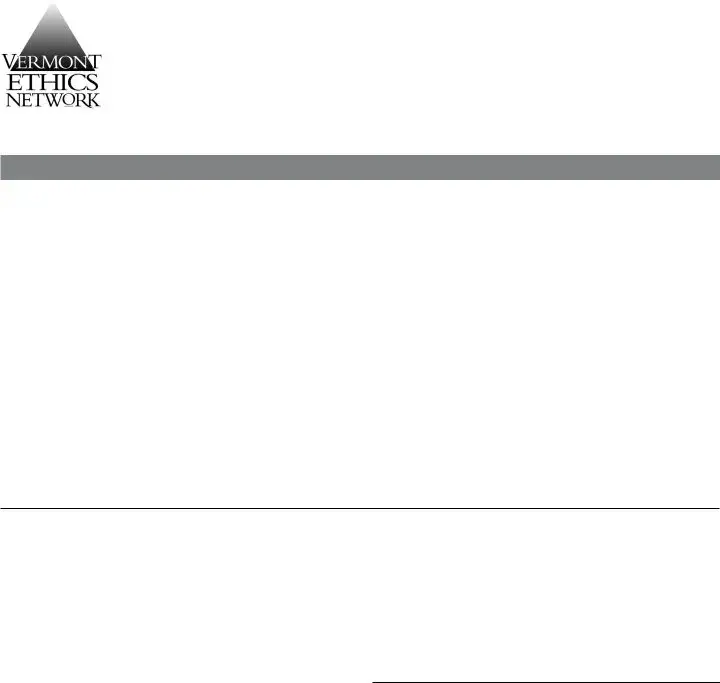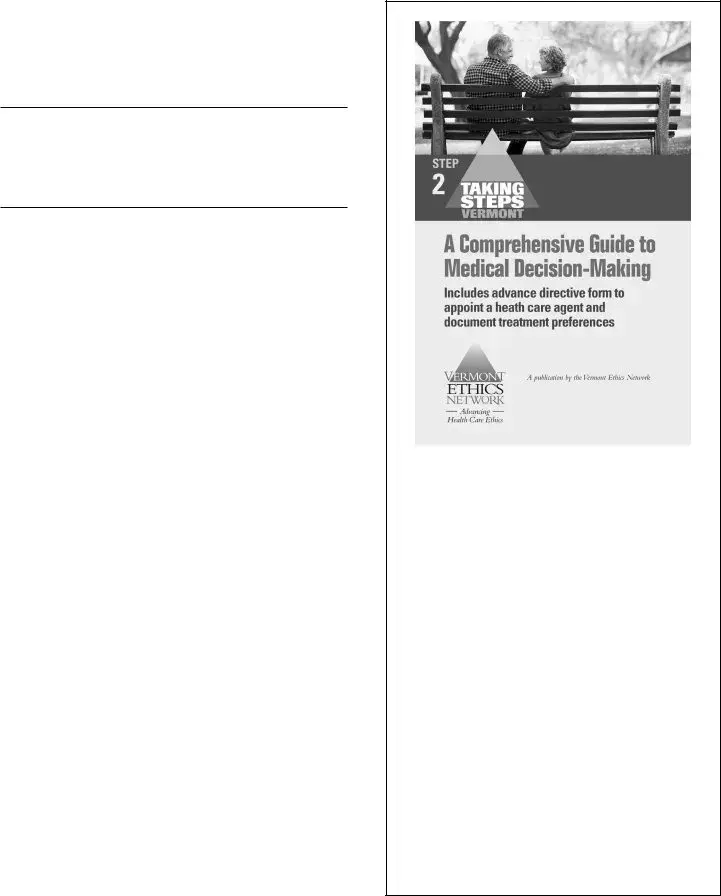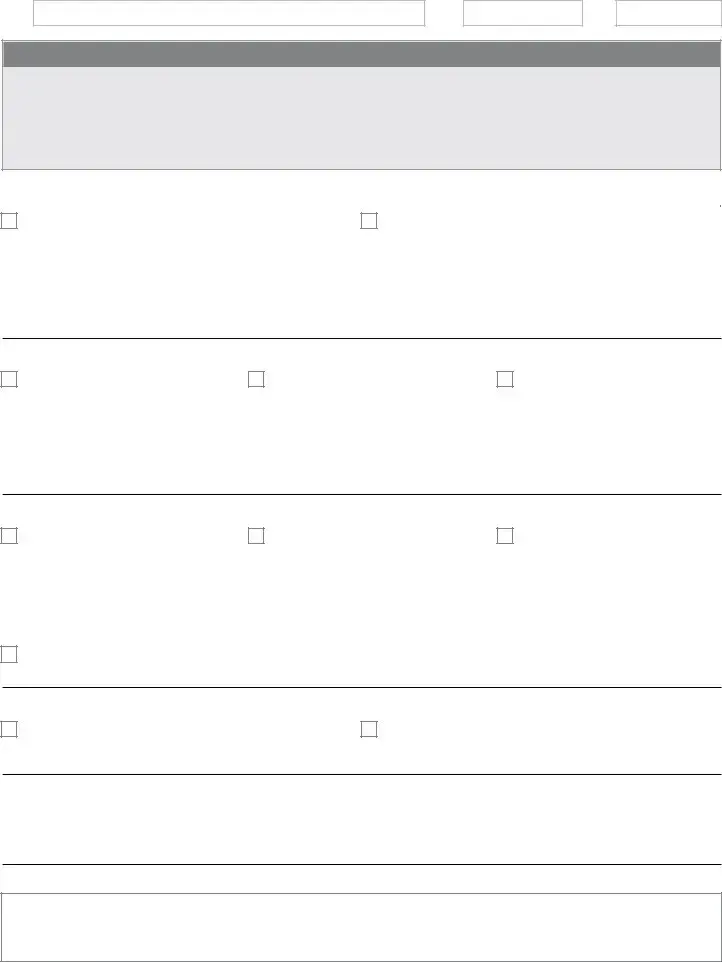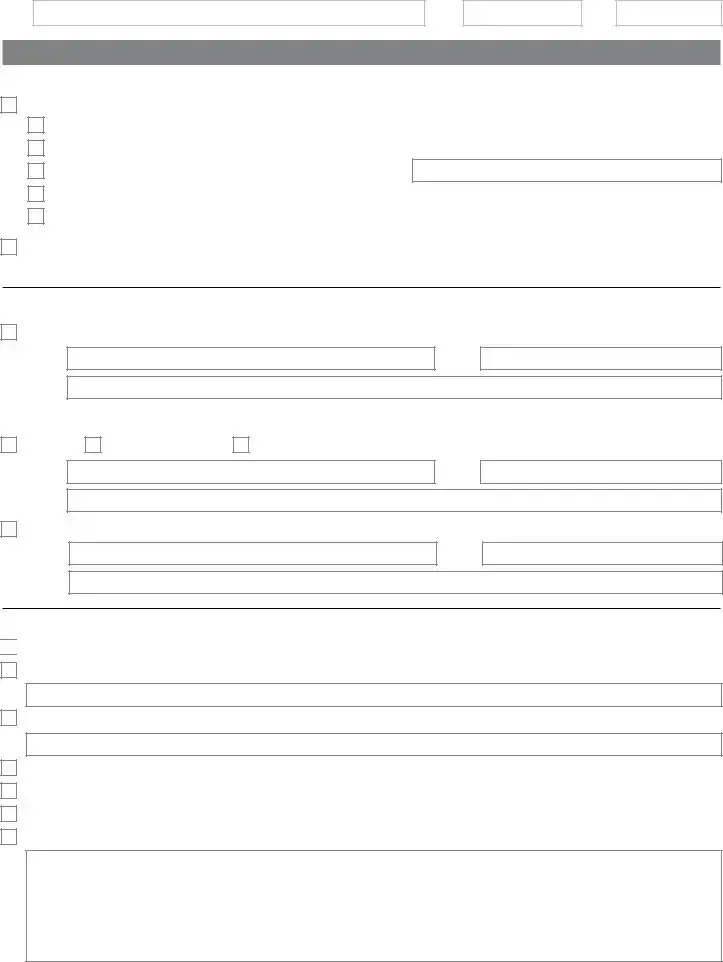Vermont Advance Directive for Health Care
Prepared by the Vermont Ethics Network
EXPLANATION & INSTRUCTIONS
■You have the right to:
1.Name someone else to make health care decisions for you when or if you are unable to make them yourself.
2.Give instructions about what types of health care you want or do not want.
■It is important to talk with those people closest to you and with your health care providers about your goals, wishes and preferences for treatment.
■You may use this form in its entirety or you may use any part of it. For example, if you only want to choose an agent in Part One, you may fill out just that section and then go to Part Five to sign in the presence of appropriate witnesses.
■You are free to use another form so long as it is properly witnessed. More detailed forms providing greater options and information regarding mental health care preference can be found on the VEN website at www.vtethicsnetwork.org.
Part ONE of this form allows you to name a person as your “agent” to make health care decisions for you if you become unable or unwilling to make your own decisions. You may also name alternate agents. You should choose someone you trust, who will be com- fortable making what might be hard decisions on your behalf. They should be guided by your values in making choices for you and agree to act as your agent. You may fill out the Advance Directive form stating your medical preferences even if you do not identify an agent. Medical providers will follow your directions in the Advance Directive without an agent to their best ability, but having a person designated as your agent to make decisions for you will help medical providers and those who care for you make the best decisions in situ- ations that may not have been detailed in your Advance Directive. According to Vermont law, next-of-kin will not automatially make decisions on your behalf if you are unable to do so. That is why it is best to appoint some- one of your choosing in advance.
Part TWO of this form lets you state Treatment Goals & Wishes. Choices are provided for you to express your wishes about having, not having, or stopping treatment under certain circumstances. Space is also provided for you to write out any additional or specific wishes based on your values, health condition or beliefs.
Part THREE of this form lets you express your wishes about Limitations of Treatment. These treatments include CPR, breathing machines, feeding tubes, and antibiotics. There is space for you to write any addition- al wishes. NOTE: If you DO NOT want CPR, a breathing machine, a feeding tube, or antibiotics, please discuss this with your doctor, who can complete a DNR/COLST order (Do Not Resuscitate/Clinician Order for Life Sustaining Treatment) to ensure that you do not receive treatments you do not want, especially in an emer- gency. Emergency Medical Personnel are required to provide you with life-saving treatment unless they have a signed DNR/COLST order specifying some limitation
Vermont Advance Directive for Health Care
|
DATE OF BIRTH |
|
DATE |
|
|
|
|
|
|
|
|
|
|
|
|
|
|
|
|
|
|
|
|
|
|
|
STATE |
|
|
ZIP |
|
|
|
|
|
|
|
|
|
|
|
|
|
|
PART ONE: YOUR HEALTH CARE AGENT
Your health care agent can make health care decisions for you when you are unable or unwilling to make decisions for yourself. You should pick someone that you trust, who understands your wishes and agrees to act as your agent. Your health care provider may NOT be your agent unless they are a relative.
Your agent may NOT be the owner, operator, employee or contractor of a residential care facility, health care
facility or correctional facility where you reside at the time your advance directive is completed.
I appoint this person to be my health care AGENT:
(If you appoint CO-AGENTS, list them on a separate sheet of paper)
If this agent is unavailable, unwilling or unable to act as my agent, I appoint this person as my ALTERNATE AGENT:
Others who may be consulted about medical decisions on my behalf include:
Primary care provider (Physician, PA or Nurse Practitioner):
NAME
ADDRESS
Those who should NOT be consulted include:
(PART ONE CONTINUED NEXT PAGE) |
12/18 |
|
ADVANCE DIRECTIVE, PAGE 2
NAME
I want my Advance Directive to start:
When I cannot make my own decisions
Now
When this happens:
PART TWO: HEALTH CARE GOALS AND SPIRITUAL WISHES
My overall health care goals include:
I want to have my life sustained as long as possible by any medical means.
I want treatment to sustain my life only if I will:
be able to communicate with friends and family. be able to care for myself.
live without incapacitating pain.
be conscious and aware of my surroundings.
I only want treatment directed toward my comfort.
Additional Goals, Wishes, or Beliefs I wish to express include:
People to notify if I have a life-threatening illness:
If I am dying it is important for me to be (check choice):
At home
In the hospital
Other:
No preference
My Spiritual Care Wishes include:
My Religion/Faith:
ADDRESS
The following items or music or readings would be a comfort to me:
ADVANCE DIRECTIVE, PAGE 3
NAME
PART THREE: LIMITATIONS OF TREATMENT
You can decide what kind of treatment you want or don't want if you become seriously ill or are dying. Regardless of the treatment limitations expressed, you have the right to have your pain and symptoms (nausea, fatigue, shortness of breath) managed. Unless treatment limitations are stated, the medical team is required and expected to do everything possible to save your life.
1. If my heart stops (choose one):
I DO want CPR done to try to restart my heart.
I DON’T want CPR done to try to restart my heart.
CPR means cardio (heart)-pulmonary (lung) resuscitation, including vigorous compressions of the chest, use of electrical stimulation, medications to support or restore heart function, and rescue breaths (forcing air into your lungs).
2. If I am unable to breathe on my own (choose one):
I DO want a breathing machine |
I want to have a breathing |
without any time limit. |
machine for a short time to see |
|
if I will survive or get better. |
I DO NOT want a breathing machine for ANY length of time.
“Breathing machine” refers to a device that mechanically moves air into and out of your lungs such as a ventilator.
3. If I am unable to swallow enough food or water to stay alive (choose one):
I DO want a feeding tube |
I want to have a feeding tube |
without any time limits |
for a short time to see if I will |
|
survive or get better. |
I DO NOT want a feeding tube for any length of time.
NOTE: If you are being treated in another state your agent may not automatically have the authority to withhold or withdraw a feeding tube. If you wish to have your agent decide about feeding tubes please check the box below.
I authorize my agent to make decisions about feeding tubes.
4. If I am terminally ill or so ill that I am unlikely to get better (choose one):
I DO want antibiotics or other medication to fight infection.
I DON’T want antibiotics or other medication to fight infection.
If you have stated you DO NOT want CPR, a breathing machine, a feeding tube, or antibiotics under any circum- stances, please discuss this with your doctor who can complete a DNR/COLST form to ensure you don’t receive treatments you don’t want, particularly in an emergency situation. A DNR/COLST order will be honored outside of the hospital setting.
Additional Limitations of Treatment I wish to include:
ADVANCE DIRECTIVE, PAGE 4
NAME
PART FOUR: ORGAN/TISSUE DONATION & BURIAL/DISPOSITION OF REMAINS
My wishes for organ & tissue donation (check your choices):
I consent to donate the following organs & tissues:
Any needed organs
Any needed tissue (skin, bone, cornea)
I do not wish to donate the following organs and tissues:
I do not want to donate any organs or tissues
I want my health care agent to decide
I wish to donate my body to research or educational program(s). (Note: you will have to make your own arrangements with a medical school or other program in advance.)
My Directions for Burial/Disposition of My Remains after I Die (check & complete):
I have a Pre-Need Contract for Funeral Arrangements:
I want the following individuals to decide about my burial or disposition of my remains (check your choices):
Agent
NAME
ADDRESS
Other:
ADDRESS
Specific Wishes (check your choices): 
 I want a Wake/Viewing
I want a Wake/Viewing
I prefer a Burial — If possible at the following location: (cemetery, address, phone number)
I prefer Cremation — With my ashes kept or scattered as follows:
I want a Funeral Ceremony with a burial or cremation to follow
I prefer only a Graveside Ceremony
I prefer only a Memorial Ceremony with burial or cremation preceding
Other Details: (such as music, readings, Officiant)
ADVANCE DIRECTIVE, PAGE 5
NAME
PART FIVE: SIGNED DECLARATION OF WISHES
You must sign this before TWO adult witnesses. The following people may not sign as witnesses: your
agent(s), spouse, parents, siblings, children or grandchildren.
I declare that this document reflects my health care wishes and that I am signing this Advance Directive of my own free will.
I affirm that the signer appeared to understand the nature of this advance directive and to be free from duress or undue influence at the time this was signed. (Please sign and print)
FIRST WITNESS (PRINT NAME)
SECOND WITNESS (PRINT NAME)
If the person signing this document is being admitted to or is a current patient in a hospital, one of the follow- ing must sign and affirm that they have explained the nature and effect of the advance directive and the patient appeared to understand and be free from duress or undue influence at the time of signing: designated hospi- tal explainer, ombudsman, mental health patient representative, recognized member of the clergy, Vermont attorney, or Probate Court designee.
If the person signing this document is being admitted to or is a resident in a nursing home or residential care facility, one of the following must sign and affirm that they have explained the nature and effect of the advance directive and the resident appeared to understand and be free from duress or undue influence at the time of sign- ing: an ombudsman, recognized member of the clergy, Vermont attorney, Probate Court designee, des- ignated hospital explainer, mental health patient representative, clinician not employed by the facility, or appropriately trained nursing home/residential care facility volunteer.
The explainer as outlined above may also serve as one of the two required witnesses.
NAME
TITLE/POSITION
ADDRESS
SIGNATURE
ADVANCE DIRECTIVE, PAGE 6
NAME
The following have a copy of my Advance Directive (please check):
Vermont Advance Directive Registry |
Date registered: |
|
|
Health care agent |
|
|
|
Alternate health care agent |
|
|
|
|
|
|
|
|
Doctor/Provider(s): |
|
|
|
|
|
|
|
|
|
|
|
|
|
Hospital(s): |
|
|
|
|
|
|
|
|
|
Family Member(s): Please list: |
|
|
|
NAME
ADDRESS
NAME
ADDRESS
NAME
ADDRESS
NAME
ADDRESS
NAME
ADDRESS
Other:
NAME
ADDRESS
NAME
ADDRESS
NAME
ADDRESS
NAME
ADDRESS
NAME
ADDRESS
NAME
ADDRESS
Vermont Advance Directive Registry
REGISTRATION AGREEMENT
VERMONT DEPARTMENT OF HEALTH SOURCE CODE: 53101301
Registry Use Only
Received:
Confirmed:
1.Read the Registration Policy, and complete this Registration Agreement. Please type or print clearly. Be sure to sign and date the form.
2.Attach either a copy of your advance directive, or optionally, an Advance Directive Locator form which indicates only the physical location of your advance directive so that it can be retrieved.
3.Registrations MUST include a completed and signed Registration Agreement form, and a copy of your advance
|
directive document. |
|
|
|
|
|
|
|
|
|
|
|
|
|
|
|
|
|
|
|
|
|
|
|
|
|
|
|
|
|
|
|
|
|
|
4. MAIL to: |
Vermont Advance Directive Registry (VADR) |
|
|
|
|
|
|
|
|
|
|
|
|
|
|
|
|
|
|
|
|
|
|
|
|
|
|
|
|
|
|
PO Box 2789 |
|
|
|
|
|
|
|
|
|
|
|
|
|
|
|
|
|
|
|
|
|
|
|
|
|
|
|
|
|
|
|
|
|
|
|
|
Westfield, NJ 07091-2789 |
|
|
|
|
|
|
|
|
|
|
|
|
|
|
|
|
|
|
|
|
|
|
|
|
|
5. OR FAX to: |
908- 654-1919 |
|
|
|
|
|
|
|
|
|
|
|
|
|
|
|
|
|
|
|
|
|
|
|
|
|
|
|
|
|
|
For additional information visit: http://healthvermont.gov/vadr/ or call 1-888-548-9455 |
|
|
|
|
|
|
|
|
|
|
|
|
|
|
|
|
|
|
|
|
|
|
|
|
|
|
|
|
|
|
|
|
|
|
|
|
|
|
|
|
|
|
|
|
|
Registrant |
|
|
|
|
|
|
|
|
|
|
|
|
|
|
|
|
|
|
|
|
|
|
|
|
|
|
|
|
|
|
|
|
|
|
Name: First |
|
|
|
|
Middle |
|
|
|
Last |
|
|
|
|
|
|
|
|
|
|
|
|
|
Suffix |
|
|
|
|
|
|
|
|
|
|
|
|
|
|
|
|
|
|
|
|
|
|
|
|
|
|
|
|
|
|
|
|
|
|
Gender: Male |
_ |
Female |
|
|
|
Date of Birth (MM/DD/YYYY): |
|
|
|
|
|
|
|
|
|
|
|
|
|
|
|
|
|
|
|
|
|
|
|
|
|
|
Primary Mailing Address: |
|
|
|
|
|
|
|
|
|
|
|
|
|
|
|
|
|
|
|
|
|
|
Apt # |
|
|
City/Town: |
|
|
|
|
|
|
|
|
|
|
State: |
|
|
|
|
|
Zip: |
|
|
Phone: Home |
|
|
|
|
|
Work |
|
|
|
|
|
|
|
|
Other |
|
|
Secondary Mailing Address: |
|
|
|
|
|
|
|
|
|
|
|
|
|
|
|
Apt # |
|
|
City/Town: |
|
|
|
|
|
|
|
|
|
|
State: |
|
|
|
|
|
Zip: |
|
|
Emergency Contacts |
|
|
|
|
|
|
|
|
|
|
|
|
|
|
|
|
|
|
|
|
|
|
|
|
|
|
|
|
|
|
|
|
|
|
Primary: Name |
|
|
|
|
|
|
|
|
|
|
|
|
|
|
Relationship to Registrant: |
|
|
Mailing Address: |
|
|
|
|
|
|
|
|
|
|
|
|
|
|
|
|
|
|
|
|
|
|
|
|
|
|
|
|
|
|
|
|
|
|
|
City/Town: |
|
|
|
|
|
|
|
|
|
|
State: |
|
|
|
|
|
Zip: |
|
|
Phone: Home |
|
|
|
|
|
|
Work/Other: |
|
|
|
|
|
|
|
|
|
|
|
|
|
|
|
|
|
|
|
|
|
|
|
|
|
|
Secondary: Name |
|
|
|
|
|
|
|
|
|
|
|
|
|
|
Relationship to Registrant: |
|
|
Phone: Home |
|
|
|
|
|
|
Work/Other: |
|
|
|
|
|
|
|
|
|
|
|
|
|
|
|
|
|
|
|
|
|
|
|
|
|
|
I, |
|
|
|
|
|
|
|
|
|
|
|
(print name) request that my advance directive be registered in the |
Vermont Advance Directive Registry, and authorize its access as allowed by Vermont law. By signing below, I acknowledge and affirm that: the information provided is accurate; I have read, understand, and agree to the terms of the Registry Registration Policy; I will safeguard my registrant identification number and wallet card from unauthorized access; and I will immediately notify the Registry in writing of changes to my registration information or advance directive. I execute this agreement voluntarily and without coercion, duress, or undue influence by any party. I understand that anyone who has access to my wallet card can use it to gain access to my documents and personal information. This authorization remains in effect until I revoke it.
Signature of Registrant: |
|
Date: |
VERMONT ADVANCE DIRECTIVE REGISTRY
REGISTRATION POLICY
An advance directive is a legal document that conveys a person’s wishes regarding their health care treatment and end of life choices should they become incapacitated or otherwise unable to make those decisions. The Vermont Advance Directive Registry is a database that allows people to electronically store a copy of their advance directive document in a secure database. That database may be accessed when needed by authorized health care providers, health care facilities, residential care facilities, funeral directors, and crematory operators. For more information, visit: http://healthvermont.gov/vadr/.
1.To register an advance directive, the registrant must complete and send the Registration Agreement form along with a copy of the advance directive to:
The Vermont Advance Directive Registry
PO Box 2789
Westfield, New Jersey 07091-2789
2.Upon receipt of the Registration Agreement and attachments, the Registry will scan the advance directive and store it in the database along with registrant identifying information from
the Registration Agreement. The Registry will send a confirmation letter to the registrant along with a registration number, instructions for using the registration number to access documents at the Registry website, a wallet card, and stickers to affix to a driver’s license or insurance card. The registration is not effective until receipt of the confirmation letter and registration materials is made by registrant.
3.Registrants should share the registration number from the wallet card with anyone that should have access to their advance directives: for example, the registrant’s agent, family members, or physician. Anyone may access a person’s advance directive using the registration number. Additionally, when the registration number is not readily available, an authorized health care provider can search the Registry for a specific person’s advance directive using a registrant’s personal identifying information.
4.The registrant is responsible for ensuring that:
a.The advance directive is properly executed in accordance with the laws of the state of Vermont.
b.The copy of the advance directive sent to the Registry, if a photocopy of the original, is correct and readable.
c.The information in both the Registration Agreement and advance directive documents is accurate and up to date.
d.The Registry is notified as soon as possible of any changes to the advance directive or registration information by completing and submitting an Authorization to Change form with the changes appended, or preferably, with an updated copy of the advance directive to the Registry.
5.Initial registration as well as subsequent changes and updates to the registration information or the advance directive documents are free of charge.
6.The Registration Agreement shall remain in effect until the Registry receives reliable information that the registrant is deceased, or the registrant requests in writing that the Registration Agreement be terminated. When the Agreement is terminated, the Registry will remove registrant’s advance directive from the Registry database, and the file will no longer be accessible to providers.
7.Only the Registry can change the terms of the Registration Agreement.










